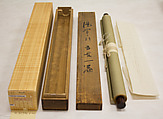Going to the War
Fukuda Kodōjin 福田古道人 Japanese
Not on view
This calligraphic composition by the modern literatus Fukuda Kodōjin features his own poem written in a dynamic mixture of semi-cursive and cursive scripts. The calligrapher's use of brushstrokes with modulated thicknesses in most of the characters showcases Kodōjin’s skill at constantly rolling the brush tip, while the smooth and robust brushstrokes in certain characters, such as "平 conquer" and "凱 victory," lend a sense of power and strength to the war-themed poem.
我皇赫斯怒, 仁義勒大兵。
白日照萬里,/ 堂々旗幟明。
百戰平胡虜,天下帰廓清。/
父母曰行矣,男児事遠征。
馬上功成日,帰来/各為栄。
萬人齊一凱,春風遍皇城。
Our emperor is filled with fury.
He sends forth his righteous troops to fight.
The sun shines bright for ten thousand miles,
our flags are a majestic sight.
Hundreds of battles are fought to conquer and subdue the barbarians.
The world is restored to justice once again.
As parents bid their sons farewell,
The young men go on the expedition.
They ride to victory on horseback,
Each returning covered in glory.
Ten thousand soldiers gather to celebrate the victory.
Spring breezes blow through the imperial capital.
(Translated by Tim Zhang)
Fukuda Kodōjin was a poet, calligrapher, and Nanga painter active in Kyoto in the early twentieth century. According to the box inscription, this work was done in 1936. That year, after an uprising against the government and assassinations by young army officials, the army gained unprecedented political power within Japan and expanded its military presence in China. The following year, the Second Sino-Japanese War occurred. Therefore, this work was likely commissioned to be presented to a lieutenant going to war in China.
Due to rights restrictions, this image cannot be enlarged, viewed at full screen, or downloaded.
This artwork is meant to be viewed from right to left. Scroll left to view more.








